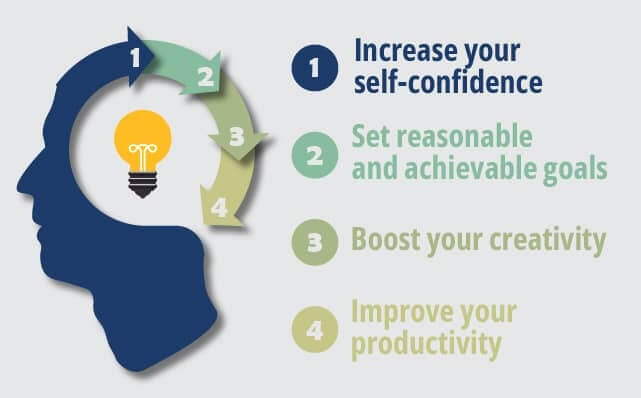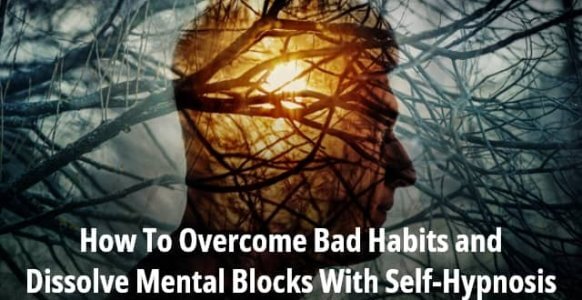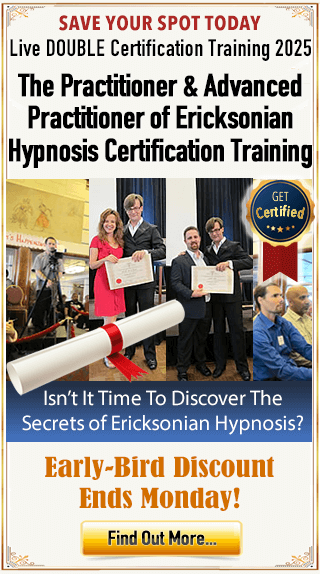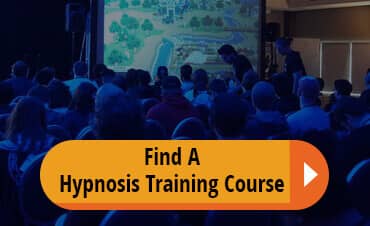How To Hypnotize Yourself: Discover The Easy 6-Step Self Hypnosis Formula
Interested in reaping the many rewards that come from a regular self hypnosis practice, but not quite sure how to hypnotize yourself?
Got good news for you.
This article will carefully walk you through everything you should know about self-hypnosis and the 6 steps to hypnotize yourself.
Now, let’s talk about what is self- hypnosis.
What is Self Hypnosis?
Self hypnosis or self hypnotherapy is a lot easier to learn than you might think (it’s actually very similar to meditation).
Anyone can master self-hypnosis techniques – all it takes is some practice and dedication on your behalf.
It’s a little like going to the gym – at first your muscles don’t have much stamina, but as you continue to train, they get stronger and stronger, and what once seemed difficult, now you’re able to accomplish with ease.
The Benefits Of Hypnosis
Research has shown that hypnosis can be used as a tool to bring about significant lifestyle changes to many areas of your life.
Hypnosis can help you to:
- Relax
- Relieve stress
- Manage pain
- Help treat addictions
- Build confidence and self- esteem
- Overcome sleep disorders
- Cure phobias
- Break bad habits
- Lose weight
- Alleviate anxiety
- Battle depression
- Set achievable goals
- Change any limiting behavior
- Solve problems
- Release creative blocks
What Can you Accomplish with Self Hypnosis?
Learning how to hypnotize yourself is much the same – it might seem uncomfortable or even impossible to begin with, but with time, you’ll find using hypnotic techniques easier and easier.
Eventually, you’ll begin to wonder how you ever got through your week without spending some time going inwards.
If you are interested to know about the power of self-hypnosis and self hypnotherapy, check out this online training program.
To discover how to get started with a self hypnosis practice, check out these self-hypnosis techniques and step-by-step guide.
Is Self Hypnosis the same as Meditation?
Meditation is often associated with hypnosis. Both disciplines are often linked to each other. Both involve entering in a calm state of mind.
In meditation, no particular goal in mind needs to be achieved. It’s more of achieving your center, being in the present and tapping in positive energies regardless of intention.
Here’s how to practice meditation on a basic level:
- Get comfortable in a quiet place where you won’t be disturbed for 15 minutes or so.
- Close your eyes and breathe slowly and deeply, breathing in through your nose and out through your mouth.
- Focus on your breath. If your attention wanders, simply concentrate on your breathing again.
- When you’re ready to end your session, open your eyes, stand up, stretch, and return your awareness to your surroundings.
The first 3 steps are quite the same as a self-hypnosis induction.
But that does not necessarily mean that meditation and self-hypnosis are the same.
They are still far from each other since self-hypnosis is let’s say, more technical since it requires execution of hypnotic techniques(but can be executed easily one undergoes the right training).
>>To know more about the difference between hypnosis and meditation, check out The Difference Between Meditation And Self-Hypnosis (And Why The Super Successful Make Them Part Of Their Morning Routines)
Learn Self Hypnosis: How to Hypnotize Yourself
Anyone can effortlessly slip into what is known as “trance”- as it’s a natural state of being.
For example, when watching TV or reading a book, your mind drifts off because you’re not paying attention to what’s going on around you.
For a few seconds, your conscious mind shuts off. You stop analyzing things and simply float away to a relaxing, peaceful place.
That’s hypnosis.
in these cases, it happens by accident. But when you hypnotize yourself and conduct self hypnotherapy and set a clear purpose, you can make long-lasting, positive improvements to your life.
Self Hypnosis in Medicine
The link between hypnosis and medicine has been a well- researched topic among scholars and researchers in recent year.
The results were astounding in the treatment and management of anxiety, phobia, eating disorders, pain management and other conditions.
Now, let’s take a look at some case studies that involved self-hypnosis in medicine.
Dealing with Dental Phobia
A study illustrates that anxiety-provoking stimuli can be reduced through self-hypnosis.
Using fMRI (functional magnetic resonance imaging) various fear structures of the brain were examined and the results were surprising. It showed significant changes in the fear centers.
This includes the actual dental surgery, endodontic treatments, and anesthesia.
The conclusion of this study exhibits that hypnosis is a powerful way in inhibiting reaction of fear circuitry structures in dental phobia patients.
Self Hypnosis For Treatment Of HIV Neuropathic Pain
Distal sensory polyneuropathy (DSP) is the most common nervous system complication of HIV disease.
This study was published on behalf of the American Academy of Pain Medicine. The study was done to find out if hypnosis can help in the management of painful HIV-DSP.
The study revealed that 72% of the subjects had overall improved pain scores.
Self Hypnosis and Pain Management in Childbirth
One of the most popular use of self-hypnosis is pain management.
Self-hypnosis has become even more popular as a way to manage pain during childbirth.
Hypnosis is particularly being used as one of the most effective methods in labor pain management that a term is coined for this specific field – Hypnobirthing.
This particular study is a thematic network analysis. Thematic analysis is one of the most common form of analysis in qualitative research.
Researchers randomly selected 48 women from the 343 that took place in the intervention group.
Data revealed positive experiences of self-hypnosis which surfaced feelings of calmness, confidence and empowerment among the women subjects.
The participants came to the conclusion that self-hypnosis has significantly made a positive impact in their childbirth.
Another study where 1,222 women who had never been pregnant participated.
The participants were split into 3 groups: a group where a group of participants were taught self hypnosis techniques, the second group was taught relaxation techniques, and lastly a group where women are given the standard care.
The self-hypnosis group had better pain management and more positive experience during childbirth than the relaxation group and the standard care group.
>> Related Article: How Effective Is Hypnobirthing? Discover The Benefits, Techniques & Success Stories Behind Having A Fear-Free Birth
How To Hypnotize Yourself Using the PIRATE Formula
All methods of hypnosis use the same basic elements:
- Induction Stage– relax your body
- Change Stage– your hypnotic state where you can address the issue you want to work on
- Exit Stage – bring yourself back to full waking consciousness
To learn how to master each of these stages and use self-hypnosis to improve your life, follow the simple 6- Step PIRATE formula below:
Step 1: P is for Privacy
- To be able to hypnotize yourself, you need peace and quiet.
- If sitting in complete silence is too difficult, try listening to soothing music with headphones.
- To start with, set a time limit of 15 minutes.
- Commit to this timeframe by saying out loud that you will come out of trance at the end of this period. Alternatively, set an alarm or choose a piece of music that’s a specific length that will gently rouse you from your trance.
MYTH BUSTER #1: No matter what happens, it’s impossible to get stuck in a hypnotic trance!
Step 2: I is for Intention
- Identify your intention for hypnosis before you go deeper into your hypnotic state. Is it to break a habit, set goal or simply relax? Make sure it’s clear in your mind.
- Write your intention down on a piece of paper and say it out loud. This helps to prime the unconscious and get ready to tackle the issue in advance.
For example:
If you’re trying to beat a sugar addiction, you might say: “I am able to survive easily without sugar”.
Step 3: R is for Relaxation
- The easiest way to be in your relaxed state is to get comfortable and focus on your breathing.
- Breathe slowly in through your nose, and out through your mouth. With every breath you take you’ll feel your body relaxing.
Tip: While this is the easiest step of all, don’t let that fool you! Focusing on your breathing helps you get settled so you’re able to enter a trance-like state!
Step 4: A is for Actualization
- When you’re feeling calm and relaxed, the next step is to go deeper.
- You do this by taking action in your mind through visualization.
- It’s the same process you might use when you count sheep at night to try and get to sleep.
For example:
Imagine yourself descending a flight of stairs. As you go down, count out each step in your head, from 1-10.
With each number, you’ll become more and more relaxed, until you reach the bottom of the stairs and feel positively tranquil.
MYTH BUSTER #2: You can’t hypnotize yourself to do something that goes against your will!
Step 5: T is for Transformation
- This is the point where you focus on the change you want to make.
- One way to do this is by repeating your intention in a series of affirmations, which should be positive statements in the present tense. If avoiding sugar is your goal, you might say:
- I am strong and full of willpower
- I resist sugar and sweet foods easily
- I eat healthy foods that nourish and sustain me
- If your goal is to solve a problem, you can also add visualization at this point. See the problem as a large boulder and imagine it crumbling away into dust.
- Or picture the problem written down on a piece of paper that simply gets lifted up and blown away by gust of fresh, invigorating air.
NOTE: When you’re in a trance, your focus is inward. Your conscious mind is temporarily switched off. These statements are therefore able to make their way into your unconscious mind, changing your behavior from the inside out.
Step 6: E is for Exit
- One technique to exit from trance is to count backwards from 10 to 1, telling yourself that when you reach the number 1 you’ll be awake again.
- Or if you set an alarm or put on a timed piece of music in step 1, this will be your signal to come out of trance.
- Another way to end a session is to just let it happen naturally. Even if you don’t set a time limit or a cue to wake you, you’ll come out of the trance anyway.
- If you fall asleep, you’ll wake up when you need to. If you don’t fall asleep, your body and mind will prompt you to return to your normal waking state.
And that’s it! When practiced regularly, self-hypnosis really is this easy.
Meaning anyone- including you – can use it to not only achieve a deep state of relaxation, but for stress relief, pain relief, to overcome sleep disorders, goal setting and many more emotional and physical issues- 100% naturally.
IMPORTANT: Hypnosis is painless, non-invasive and perfectly safe! And remember, it takes practice to get good at anything. If you don’t succeed the first time, try again!
And to find out how self hypnosis can be used to help you reach a particular goal, experience inner healing or even reach heightened states of conscious awareness, you might be interested in our groundbreaking self-hypnosis homestudy program, Beyond Self Hypnosis.
Created by one of the world’s leading hypnotist and creator of conversational hypnosis, Igor Ledochowski, Beyond Self-Hypnosis will expand the limits of your unconscious mind and upgrade your mind’s “architecture.” Yep… it’s really powerful stuff.









![[ADVANCED GUIDE] How To Master Hypnotic Regression Therapy - Part I: Essential Principles To Profoundly Transform Your Subject’s Emotional Trauma [ADVANCED GUIDE] How To Master Hypnotic Regression Therapy - Part I: Essential Principles To Profoundly Transform Your Subject’s Emotional Trauma](https://hypnosistrainingacademy.com/wp-content/uploads/2016/09/hypnotic-regression-therapy-essential-principles.jpg)



![Yogic Breathing For Hypnosis: 3 Easy Techniques To Ground & Relax Your Clients Before Inducing A Hypnotic Trance [Includes Infographic] Yogic Breathing For Hypnosis: 3 Easy Techniques To Ground & Relax Your Clients Before Inducing A Hypnotic Trance [Includes Infographic]](https://hypnosistrainingacademy.com/wp-content/uploads/2019/05/yogic-breathing-for-hypnosis.jpg)
